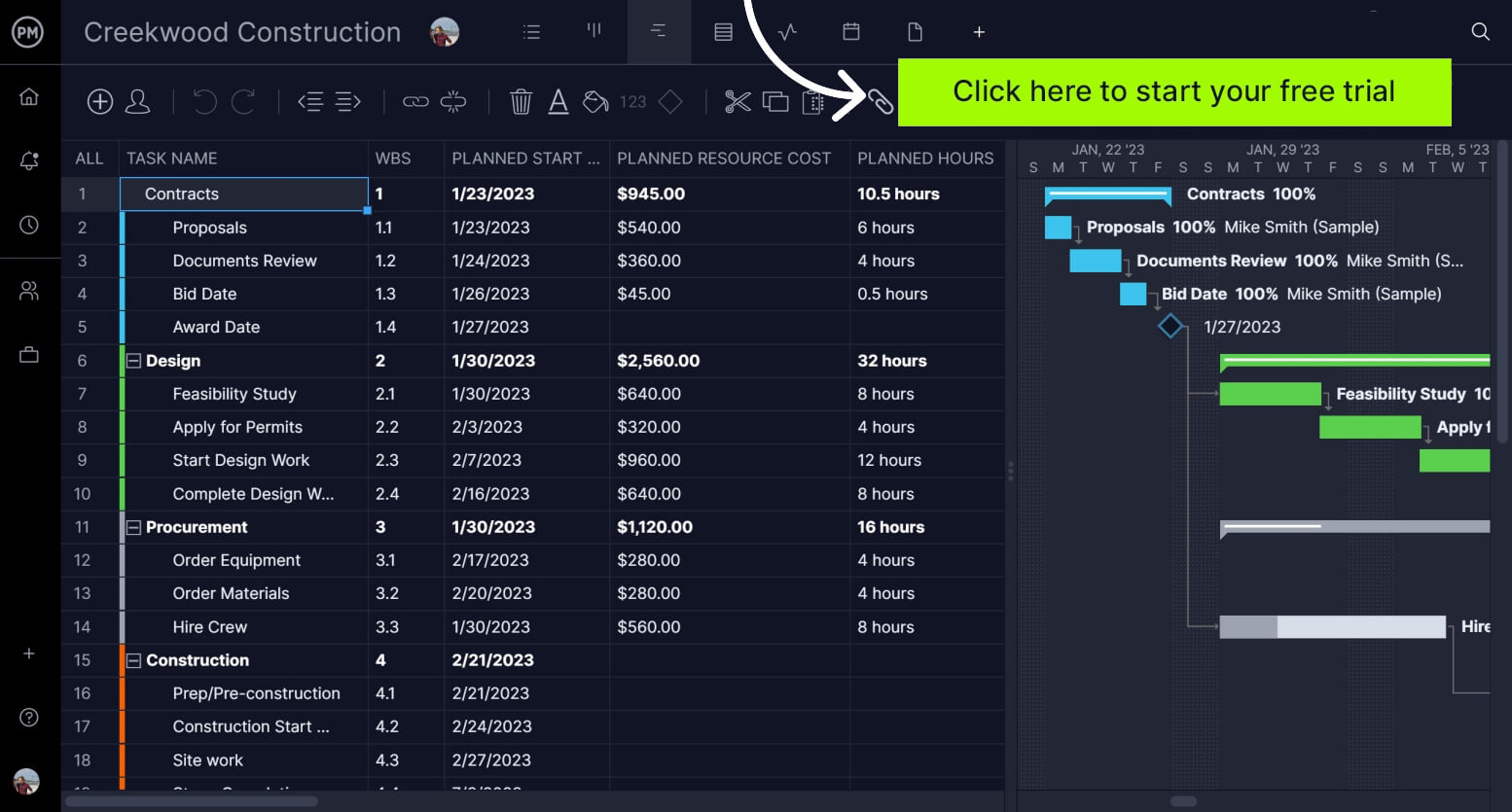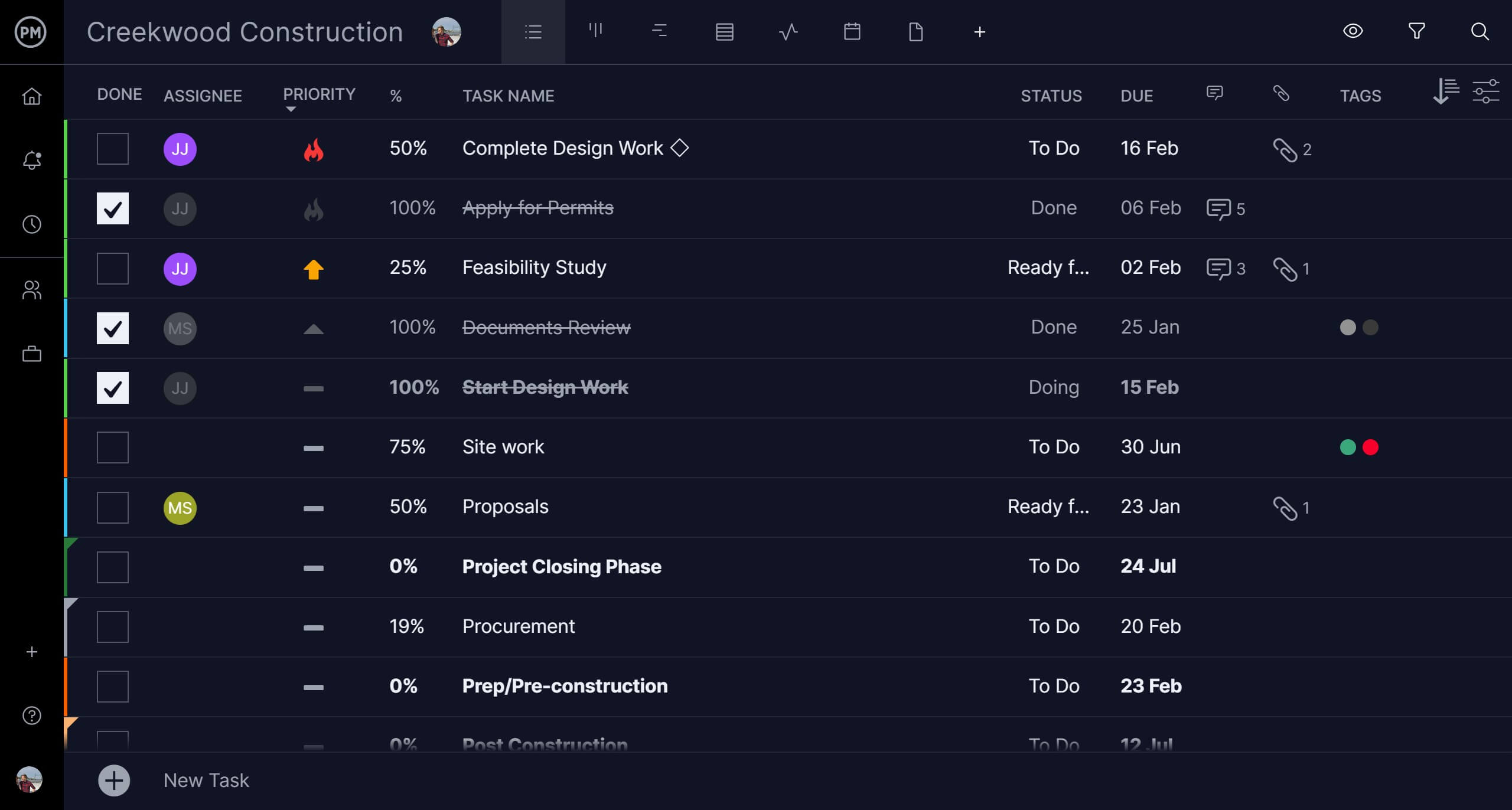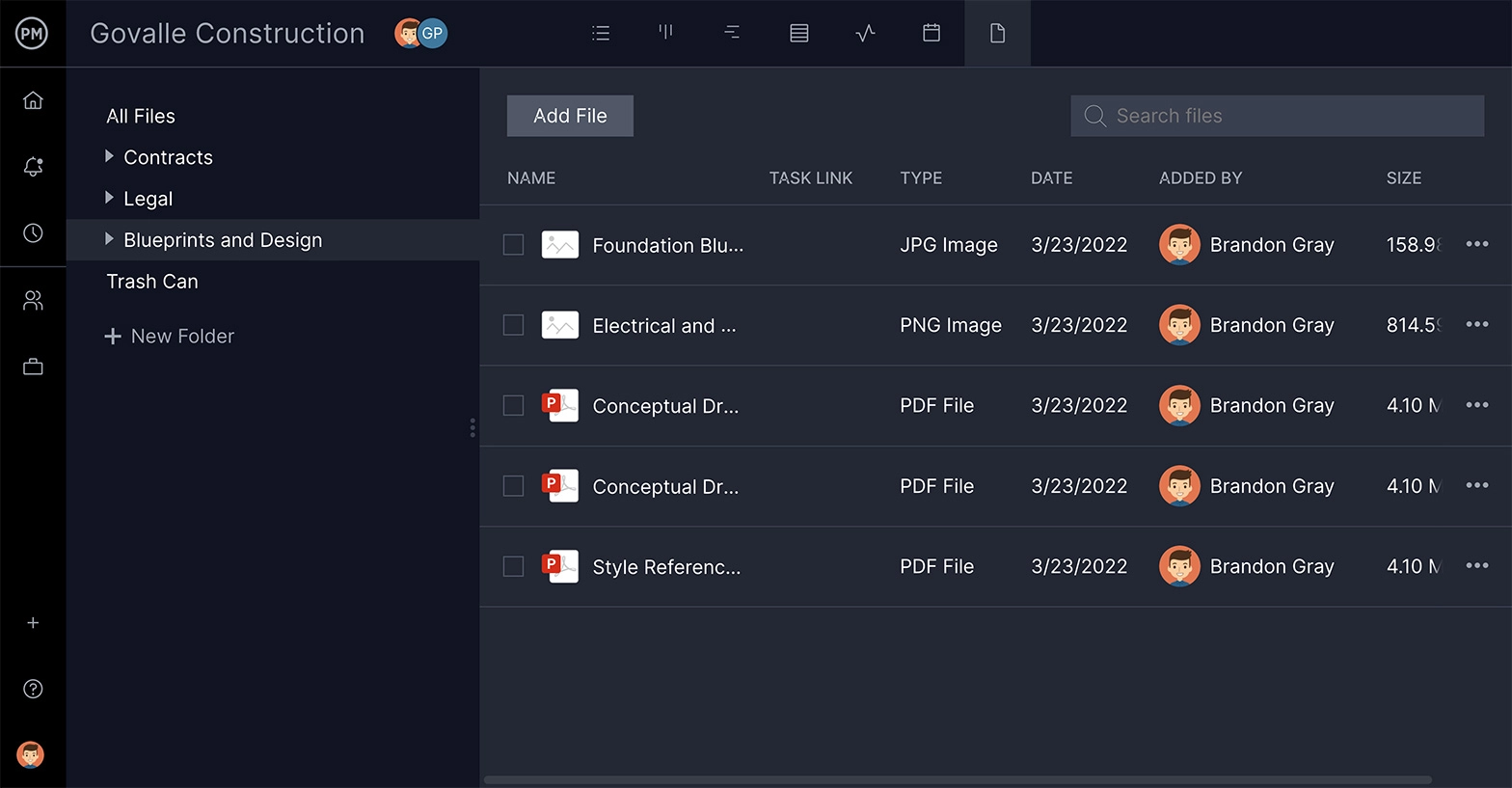Construction projects are unique in that they require architectural drawings. These construction drawings are used for new construction, remodeling and nearly every type of construction project you can imagine. Building drawings aren’t a monolith, though. There are many types of architectural drawings.
Let’s take a look at the different types of construction drawings, what purpose they serve in construction project management and how project management software helps turn these building construction plans into actionable steps that guide the construction crew during the execution phase of the project.
What Is an Architectural Drawing?
An architectural drawing can be a sketch, plan, diagram or schematic. Whatever form it takes, the architectural drawing is used to communicate detailed information about what’s being built. These technical drawings are made by architects according to a set of standards, such as the view, which can be a floor plan, section or another perspective of the building, sheet sizes, units of measurement and scales, annotation and cross-referencing.
In the past, these construction drawings and specifications were done with ink and paper. Copies were made by hand, which took a lot of time and effort. This led to drawing on tracing paper and, with the development of the computer, almost all architectural construction drawings are done on computer-aided design (CAD) software.
There are many types of architectural drawings, most of which are a combination of words and pictures. They all communicate precise details on the style and aesthetics of the construction project. Various types of blueprints are used in vertical constructions, such as architectural, structural, heating, ventilation and air conditioning (HVAC), electrical and plumbing, fire protection plans, etc.
Whatever the output of the construction project, the construction diagram is a necessary step that leads to the construction project plan. Project management software is essential to move from architectural drawings to viable project plans. ProjectManager is award-winning project management software that has powerful Gantt charts that organize your tasks, link all four dependencies to avoid costly delays and even filter for the critical path. Once your plan is complete, set a baseline to compare the planned effort against your actual effort to help you stay on track. Get started with ProjectManager today for free.

What Is the Purpose of Architectural Drawings?
The purpose of architectural drawings is to communicate the design and layout of a structure that’s to be built or remodeled. These construction drawings are used by architects, builders, engineers and other construction professionals working on the project. In fact, the architectural drawings are important to all project stakeholders.
Another reason for architectural drawings is that they’re used for getting building permits, zoning approvals and other regulatory requirements. Construction projects cannot break ground until they’ve been legally approved. They must follow code and safety regulations and the construction drawings allow regulators to determine if the plans meet these standards.
Engineers use architectural drawings to work on mechanical, electrical and plumbing (MEP) features in the building or structure. It allows them to understand the space and figure out how they’ll put their systems within the building. Contractors also use these building drawings to understand what building materials they’ll need as well as other requirements. It helps them with estimating costs and creating a budget for the project.
Architectural drawings have many purposes, from understanding the space in depth to convincing clients of the viability of the project. It gives everyone a better sense of the scope of the project and helps in the process of construction. The importance of construction drawings cannot be underestimated.
Types of Architectural Drawing
As noted, there are many different types of building drawings. For example, there are technical drawings, engineering drawings, shop drawings and as-built drawings. A construction project doesn’t have one single drawing, but usually, many in order to show all aspects of what’s to be constructed. Here are eight common types of architectural drawings.
Site Plan
This is an aerial view of a building and the property that surrounds it. These can include buildings that are nearby as well as infrastructure, such as roads. This architectural drawing is important in that it shows where the building is to be erected in context to the property boundaries. There can also be details about landscaping, driveways, patios and other design elements.

Floor Plan
The floor plan is the interior drawing of the building. They can include specific design elements, such as electrical or plumbing systems to detailed measurements between the walls, doors and windows of the building. There are usually surface area calculations for each room on the floor. The floor plan is going to inform the project estimate. These plans used to be 2-D drawings, but are increasingly being made in 3-D.

Source: Amatect, CC BY-SA 3.0, via Wikimedia Commons
Cross-Sectional Architectural Drawings
A cross-section architectural drawing is a 2-D rendering that serves to illustrate the various visible and hidden elements in the building. A cross-section is a view of an object as if part of it was sliced off to review the inside. This is done to the building along a vertical place allowing viewers to look in. This helps show how the building is put together, such as how walls need to be built, how windows fit into those walls and the structural transitions from one floor to another.

Landscape Architectural Drawings
Not all architectural drawings are focused on buildings or structures. There’s also the landscape surrounding the building or structure to consider. This is mostly found in residential construction and to a lesser extent in commercial buildings. The construction drawing is close to the site plan, but obviously with a focus more on the landscape. The overall layout and measurements are included.

Elevation Architectural Drawings
Here’s where the vertical plane is rendered from the view straight ahead looking at the building. It’s usually done to show the exterior of the building as seen from the front, back and side. There can also be elevation architectural drawings that show the interior view from a vertical plane as it’s done with cross-sectional architectural drawings.

Excavation Architectural Drawings
There’s also another construction site issue to deal with when making architectural drawings and that’s the excavation. There are likely to be trenches, pits, shafts, tunnels and other types of soil removal to deal with on the site and an excavation architectural drawing will detail this work. They also provide information on the excavation process.

As-Built Architectural Drawings
The as-built architectural drawings are revisions. They’re used to illustrate changes from the original plans and how the building was constructed. They’re usually marked up by the contractor to show how the building was in fact made as opposed to how it was planned to be made. This isn’t done until the construction project is completed.

Detail Architectural Drawings
This type of architectural drawing is made up of many, smaller cross-section drawings as well as close-up views of parts of the building. They provide detail, especially about how pieces of the building are put together. For example, they might show how reinforced concrete beams are assembled or custom designs, such as roof eaves and window openings.

These are eight of the more common construction drawings, but they aren’t every type you might find on a construction site. For example, there are finishing drawings regarding floor coverings, moldings, textures and colors for the final stage of construction. Location drawings include floor plans, elevations and cross-sections to show the general location of the different construction elements. All of these architectural drawings, however, fit into the larger construction planning process. Let’s take a look at how project management software helps build that bridge from building drawings to construction.
ProjectManager Helps Turn Architectural Drawings Into Successful Projects
Architectural drawings are important because they explain what has to be done in a construction project. They inform estimating and the bidding process in addition to planning. That’s when the processes and workflows are created on Gantt charts. ProjectManager is online project management software that empowers teams to plan, manage and track construction projects in real time. There are secure timesheets that allow the construction crew to log their hours on the job site with our mobile device or anywhere and at any time.
Access All Architectural Drawings Anywhere With Unlimited File Storage
Even once you have the plan in place, you’ll still need to have those construction drawings and documents available. We have unlimited file storage so every project document is available when you need to see it. Teams can share these documents and even comment at the task level, attaching images that can be sent to the supervisor back in the office if they need direction. Our collaborative software means you can get into the project whether you’re in the office, on the job site on en route to and from work.

Use Multiple Construction Project Management Tools
Construction project managers love Gantt charts as they can manage tasks, costs and resources all in one place. But that’s too much information for the crew member who is focused on building a wall or inserting a window. That’s why we have multiple project views so people can work how they want. For instance, crew members can view the plan and see their tasks on a task list or kanban board, which allows them to collaborate and gives managers transparency into their work. Calendar views are great for clients who want to see if milestones are being met.

When you have to meet with your client to update them on the progress of the project, you can use our reporting tools. There are real-time dashboards for a high-level view whenever you want, with no time-consuming setup, and customizable reports on status, portfolio (if you’re working on multiple projects), time, cost, workload, timesheets and more. You can filter the reports to see what you want to see and then share them with stakeholders.
ProjectManager is online project management software that connects teams whether they are in the office, in the field or even at home. Task management, risk management and resource management tools help keep you on schedule and teams productive. Get started with ProjectManager today for free.


